The last voyage of the Schamonchi?


In the industrial flatlands of Bushwick, beyond a truck-lined driveway to a concrete plant, through a hidden gate and down a narrow jungly path you see it: a ship, four stories high and half a football field long, jammed into a little spur of the Newtown Creek.
Standing on the deck of the MV Schamonchi, a former Martha’s Vineyard ferry that could carry up to 650 passengers, offers a unique vantage point. One occasionally glimpses water bubbling from the controversial aeration systems installed in this section of one of the most polluted waterways in the United States. The blower buildings pump air through long plastic pipes that sit on the creek floor, raising the oxygen level enough to allow for fish survival. But it sure stinks up the place.
“Look at it out there,” says Lindsay Cooper, until recently, the ship’s owner, where a slick of orange afternoon sunlight on the water is cut by the snakelike head of a heron. The harp strings of the Kosciusko Bridge are visible in the distance beyond a fleet of parked box trucks across the canal. Baitfish school next to the hull of the ship. “It’s beautiful,” she says. “I mean, It’s awful, but it’s beautiful.”
Beauty isn’t what comes up in a search of the Schamonchi. But for one early New York Times article, most stories have included descriptors such as “toxic boat,” “squatter style crash pad,” and “smelling of cat urine.” Its residents have been called “drifters,” “denizens,” or the now semi-meaningless term, “hipsters,” known for “all-night raves.”
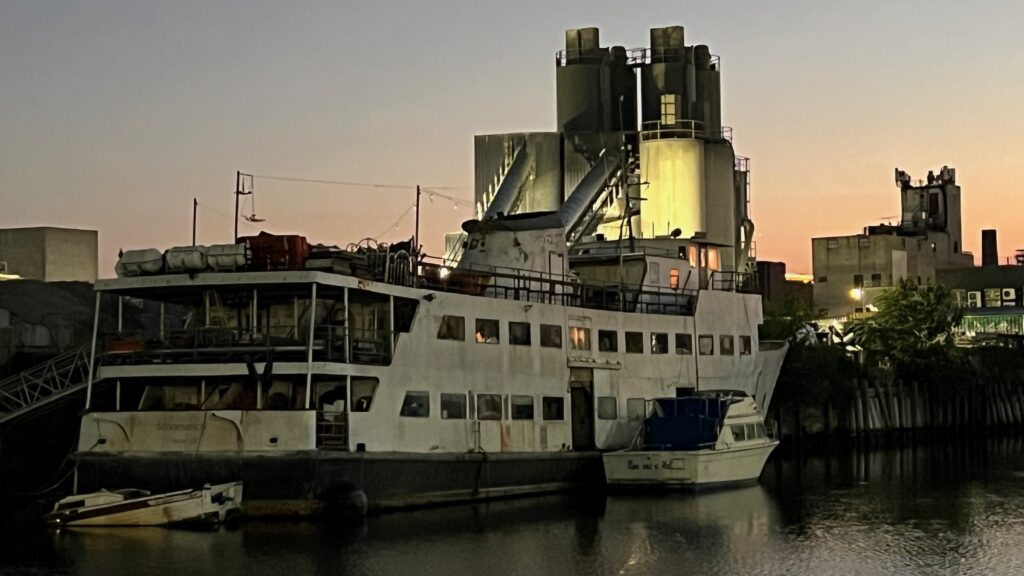
The Schamonchi at rest (Photo by Lindsay Cooper)
I have visited the ship regularly since 2008, and at times it did look like a squatter’s hang, especially early on when one had to haul a bucket of water up the side to flush the toilet.
Less known is how the ship became a unique hub in an intensely creative and diverse community, whose extended family includes metal fabricators, filmmakers, writers, holographers, aerialists, urban explorers, costumers, scientists, museum curators, engineers, prosthetics makers, and event producers, among many other types, including one entrepreneur who started a satellite launching company.
Cooper came to own the vessel after a succession of stewards, and struggled with others for a decade to develop it into a legitimate cultural gathering space. She says it’s no longer taking on water, but estimates it would cost $100,000 for repair at dry dock, and half a million dollars to make it ready for the public. “But what would it cost you to open a place in this neighborhood now?” she asks. “This is like a 6,000 square-foot building that needs a new roof — but the roof is on the bottom.”
The future of the Schamonchi is up for grabs. Despite years of effort, the monetary needs and challenges have proven too great. Cooper says the ship is now in the hands of the owners of the property where the ship is still docked. They couldn’t be reached for comment, but a neighbor says it seems like they just want the ship out of there. It’s entirely possible that the MV Schamonchi’s run has come to an end.
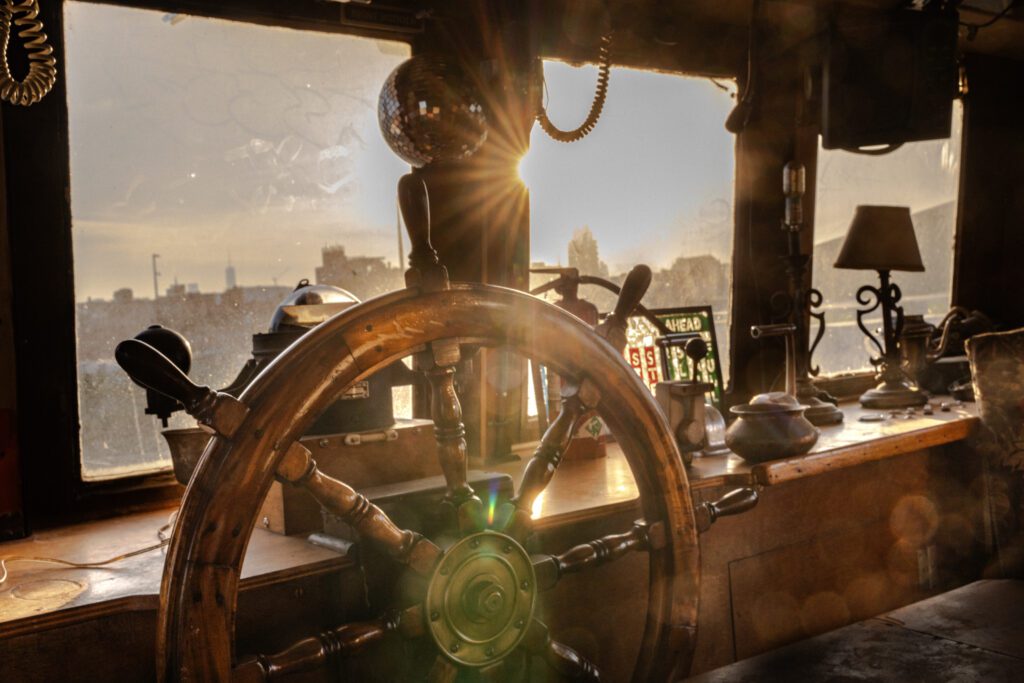
Full speed ahead (Photo by Daniel Efram)
Lost Boys on Newton Creek
Built in 1978 by the Edward T. Gamage yard in East Boothbay, Maine — partially using WWII surplus equipment — the Schamonchi carried tourists between New Bedford, Massachusetts and Martha’s Vineyard for a privately-owned company for over 20 years. The Massachusetts Steamship Authority purchased the ship in 2001, and according to local papers, “ran the business into the ground,” leaving it decommissioned from service by 2003. Two years later it was bought for $105,000 by New York-based Caribbean Shipping and Marine Services of Flushing, with the intention of turning it into a party boat. It was brought to New York, but the plan was never realized. The Schamonchi was then purchased in 2007 for an undisclosed sum by a young entrepreneur from Montana who asked only to be identified as Jonathan.
It wasn’t long before the ship became a party vessel. Through Burning Man, Jonathan had met the New York DIY and participatory art community, comprising creative tribes such as Flux Factory, Rubulad, House of Yes, Madagascar Institute, Secret Project Robot, The Danger, Gemini & Scorpio, and Silent Barn among others. Significant embers of influence also wafted over from the San Francisco Cacophony Society — the social pranksters and creative trespassers who created Burning Man’s heyday.
“It was a Peter Pan/Lost Boys kind of environment,” says Bruce Beese, who’d grown up with Jonathan, and was among the boat’s first inhabitants. “We’d go out and collect pallets to burn in the Franklin stove for heat,” he recalls. “It was really outside of this grid of the world, where creativity happens in a studio and recreation happens in a bar or venue … It was was inspiring, and attracted a lot of people who appreciated this world on the margins.”
Parked near the hidden gate were canoes, motorcycles, a UFO-shaped vehicle meant to be a mobile pizza oven, and a 1977 black Cadillac limousine previously owned by Kenny Rogers, with push button liquor dispensers on its bar. “The “scotch” button had been pressed so much it was almost illegible,” says artist Orien McNeill, who lived on the boat in 2009, and helped bring it to the deepest reaches of the waterway.
“it’s hard to move a boat that big through the canals with all these right angles,” says McNeill. “So we made a stern thruster by taking a speedboat and basically just tying it really hard to the stern, and then just yelling into the cell phone, “forward forward forward, reverse reverse reverse!”
The Schamonchi did leave its nook a few times, twice serving as mothership for McNeill’s “flotilla event” of homemade boats in Jamaica Bay, The Battle for Mau Mau Island — sort of a cross between the Idiotarod shopping cart race and Bike Kill, but on floaty things. A main builder for the Swimming Cities scrap-raft projects by the artist Swoon, McNeill once built a 65-foot water slide from the top deck. Another year featured a bar in a severely listing, half sunken tugboat near the shore, made by subversive maritime artist Duke Riley.
And what other kind of crew could get a 145-foot boat involved in a chase scene? In 2014 the ship had to move to prove to the NYFD that it wasn’t a “derelict vehicle,” and embarked on a cruise to a temporary slip in Jersey City. But apparently, a giant commercial vessel with private markings is a suspicious thing to maritime authorities, especially when headed toward three city bridges. Two coast guard gunboats pulled up on either side, and in a show of tactical grace, one swerved and within seconds boarded the Schamonchi while underway. They inspected for safety, found nothing to cite, and left as fast as they came.
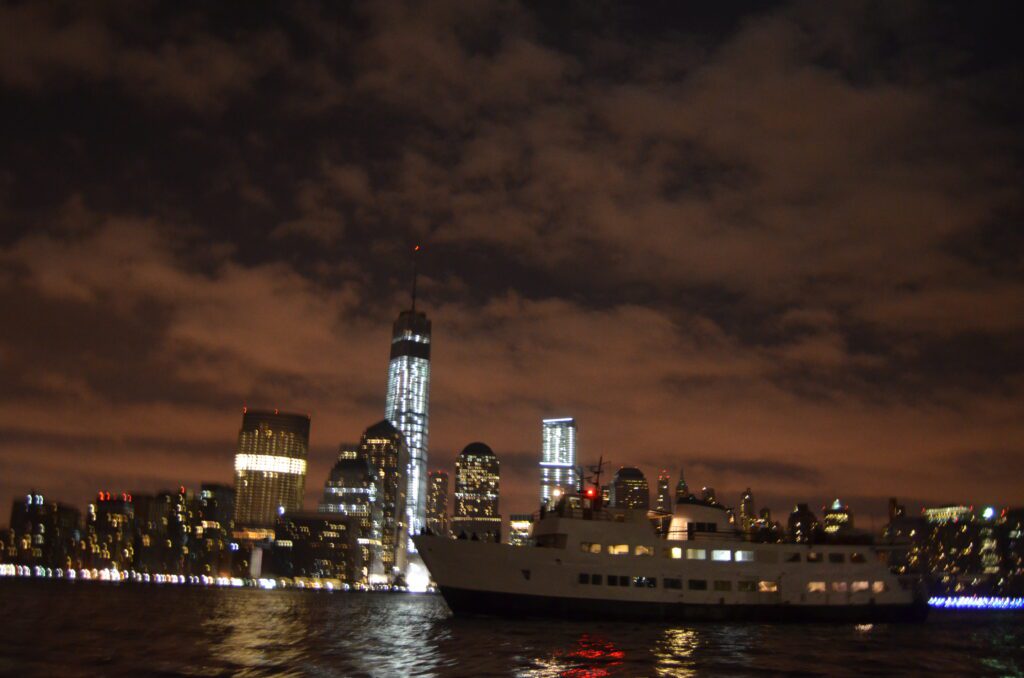
Schamonchi heads for the harbor (Photo by Dan Glass)
‘It was an ecosystem’
Sari Rubinstein, cofounder of venerable live music and art venue Rubulad, ran a couple parties on the ship early on. “The whole point of DIY spaces is that you can just do it; you don’t need someone to say it’s okay, or to accept you,” she says. “You don’t need the approval of any structure … anyone who wants can do these things.”
However, she adds that by the mid 2000s, “New York was coming into a time of intense police repression, and cabaret law enforcement and craziness.”
For those who don’t remember, dancing was actually illegal in city venues without a cabaret license — which included almost all of them. Enforcement was revived by the Giuliani administration, and lasted for over 20 years. Providing temporary cover for the Schamonchi was confusion over the jurisdiction of a vessel paying rent on a dock on private land, but floating on an industrial canal administered by the city — though, being a public waterway connected to the open ocean, was governed by the Coast Guard.
After several party raids, the FDNY in 2013 restricted living aboard the ship, and put a kibosh on events.
It was time to make legal and sustainable use of the ship, but Jonathan had a venture to pursue and needed to pass on the responsibilities. So a group of his friends bought the Schamonchi and formed Aquatorium, a membership-driven collaborative that hosted immersive theater, art studios, music studios and shows, and even pioneering technology research. This was more in line with the ship’s potential, as well as that of the community connected to it. But it was nobody’s full-time job; people were still working to survive.
The performance and events collective House of Yes was similarly skating the legal margins, and found itself across the street from the Schamonchi after losing two locations — one to rent hikes and another to fire. There were many friends in common, and carpenters based out of the ship made props and other constructions for House of Yes.
“It was an ecosystem,” says Kae Burke, co-founder of House Of Yes with Anya Sarpoznikova. Throughout the community friends supported each other with help and whatever business they could. House of Yes’ earlier incarnations were primarily art spaces, says Burke, with costume workshops and music studios — and no intention of becoming a nightclub. Just like for the Schamonchi, parties at their space paid the rent. “But it was a Venn diagram of rule breaking,” she says. “We went legal because one inspection could mean total eviction, a complete loss of home.”
Some pressures on DIY spaces did eventually ease. In 2017 New York City’s cabaret laws were finally repealed, due in no small part to the work of this community. The Office of Nightlife was also created to help spaces navigate city processes and agencies.
“I’m familiar with the vessel,” says Office of Nightlife Deputy Director José Soegaard, who adds he’d attended events there personally, before his current role. The office produced a report in 2018 with recommendations after a five-borough listening tour to hear comments from venue owners, workers, performers, patrons and neighborhood residents. “We did hear a lot from folks who operate DIY spaces,” he says. “A lot of that engagement helped shape these recommendations.”
The ONL defines its focus broadly as cultural activity between the hours of 6 p.m. and 6 a.m., so investing in party boats does not quite fit that mandate. One of the few options available is for the Schamonchi to become a licensed venue — a bar or nightclub.
There is a gap in the economic model where many DIY places just don’t fit. Showcases make money, whereas places of creation often do not. There is a distance between a studio and a gallery; a rehearsal space and a stage; a place where people sew and a place where things are worn. The makers may not be publicly visible, but they are essential parts of the creative ecosystems that produce and support what can later become “legitimate” culture.
How to preserve these ecosystems, if they’re not recognized?
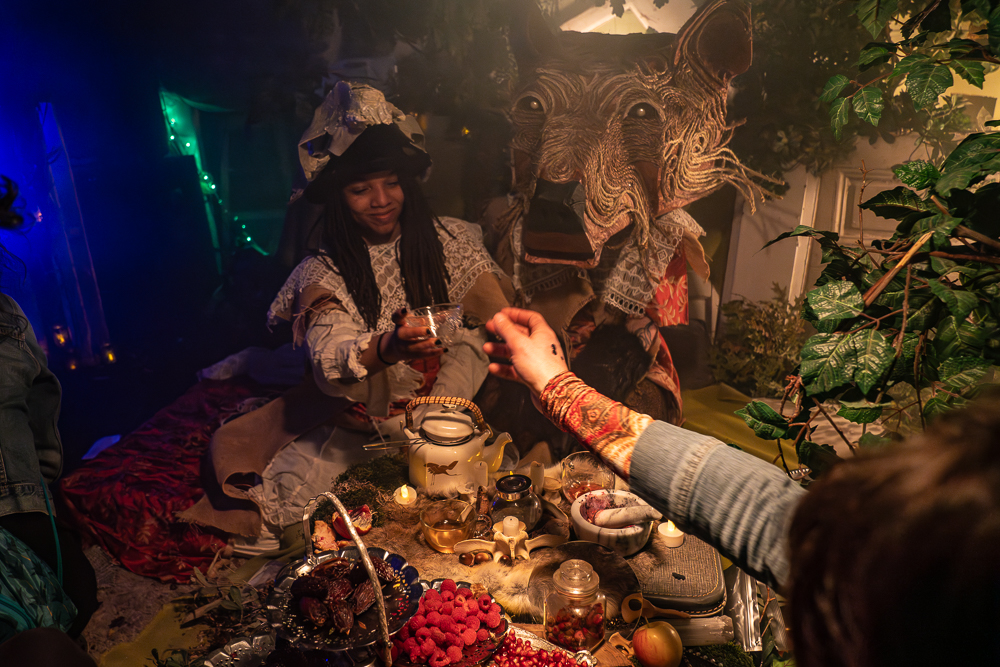
Ex Caelo, an immersive art party aboard the Schamonchi (Photo by Alix Piorun)
An uncertain fate
It’s unknown, but unlikely, that the new property owners are aware of the vibrant cultural history of the Schamonchi. However, the boat has to move at some point in the next couple years to make room for a new bulkhead wall in the creek.
If nothing else happens, there’s a non-profit organization that will haul the ship away and sink it off the coast of New Jersey to become an artificial reef, says Cooper.
This would be a shame for a vessel that’s weathered so much — not the least of which was Hurricane Sandy. Jaclyn Atkinson, who lived on the Schamonchi for three-years, was on board after the surge perched the back of the boat on the other side of the canal at a 30-degree angle. “There were transformers blowing up all around us,” she says. “I was the last person to get back on, and then the boat dropped a full 30 feet back into the water. It was a fucking Halloween ride.”
Deeply affected by the ship’s community, Atkinson co-founded a participatory event collective called Shadow Traffic, which produces free events in various hidden nooks of the city. But she would love to see the Schamonchi remain afloat.
“Each year, each event brought a new crowd or person to inspire,” she says. “I loved the look of bewildered disbelief on newcomers’ faces, that this thing could exist so close to their known world.”
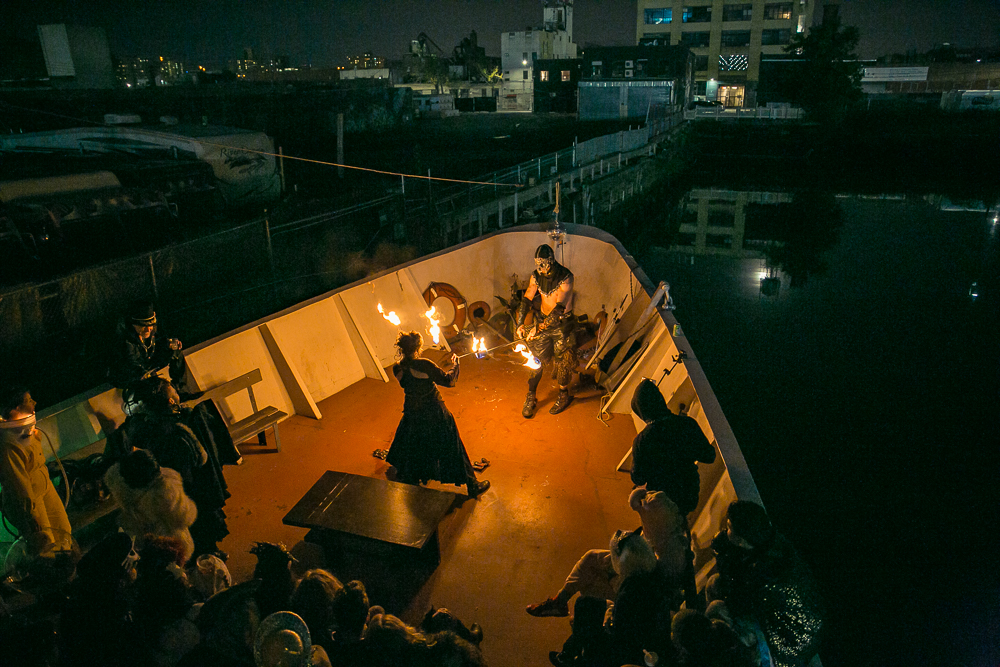
The bow of the Schamonchi in more bewildering times (Photo by Alix Piorun)
The post The last voyage of the Schamonchi? appeared first on Brooklyn Magazine.




